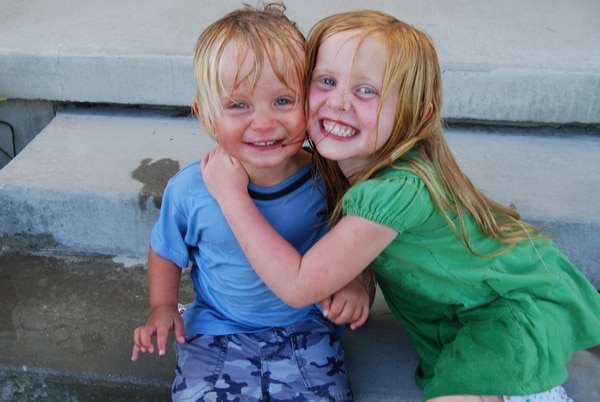Well, we have made it to the exciting conclusion of the Love Language series. I just had a few final thoughts I wanted to share with you.
BABIES and TODDLERS
Some of you might have noticed that I did not talk about Locke’s primary love language. It is partly because he could be sitting on my lap (physical touch) snuggled in (quality time), with chocolate milk in his favorite sippy cup (gift), while I read him a story (service) about how much his mamma love’s him (words of affirmation), and it still wouldn’t be enough. He is 2 years old and needs love in all different ways.
And I also didn’t mention Locke’s love language because Gary Chapman and Ross Campbell say it is difficult to figure out kids’ primary love languages before the age of 5. They “may give you clues, but their love language is rarely clearly seen.” So for now I give Locke love in all the 5 languages so that he can develop a love capacity in all the 5 languages.
DETERMINING YOUR CHILD’S LOVE LANGUAGE
I am sure you all itching to figure out your children’s love languages, if you haven’t already. Here are some ways to determine your child’s primary love language:
Notice what your child requests most.
Notice what your child frequently complains about.
Observe how they give love to you.
Observe how they give love to others.
Disguise choices of different love languages and see what they choose.
If none of these methods work for you, there is a 15 week experiment outlined in the book as well as an assessment quiz.
One word of caution: Don’t let on to your kids that you are trying to determine their love language. They are too smart and can skew the results. And they are smart enough to use their love language as a manipulation tool as well. I made this mistake with Elle. A few days after our love language talk, she came to me and said, “Mom, you know how my love language is time? Well can we go get a pedicure together?” Keep your detective work on the down low.
ALL LANGUAGES
You may have noticed that I used the word ‘primary’ a lot. That is because most of us do have a dominant or primary love language, but that is not to say that we don’t need and appreciate all of the the other love languages as well. In fact, healthy adults and children can give love in all of the different love languages. As we spend quality time with our kids, use words of affirmation, serve them, use gentle touch and give gifts, our children will be more likely to give love in a variety of ways as well. They will have healthier and happier relationships now and in the future.
GIVING and RECEIVING
We have talked much in this series about how to give love in the different love languages, but it is equally as important to be able to receive love in all of the languages. When my husband stops me and gives me a hug while I am on a mission to complete a task, he might as well be chewing gum loudly in my ear and running his fingernails down a chalkboard. But I need to see his hug as an expression of his love and receive and accept it. The way he shows love is just as valuable and important as the way I receive love.
The same is true for our children. Their drawings, notes, hugs, snuggles, and requests for time are their ways of telling me they love me. I might prefer them to just go make their bed, but I can’t discount how they show love. We are all responsible to give and receive love in all of the love languages.
CHANGE
Love Languages can be fluid especially during teen years so don’t get locked into one language with a particular child and put blinders on. It is in our best interest to always be assessing and evaluating love languages to best meet our children’s emotional needs.
BEYOND CHILDREN
The application and information of the Love Languages goes beyond our children. Think about how much this could help a marriage or an extended family. Think about if teachers and leaders understood love languages. I remember when I was a leader of 30+ teenage girls, I was discouraged. I was talking to a friend and I said, “I just don’t know what else to do. I have written them all notes…” She said maybe notes aren’t their love language. Lightbulb! We can use this information in all of our relationships.
MORE TO READ
I didn’t cover all of the chapters in the book, The Five Love Languages of Children. I needed to leave you a reason to buy the book or check it out from the library yourself. Other chapters include
Discipline and the Love Languages
Learning and the Love Languages (this would be great for teachers!)
Anger and Love
Speaking the Love Languages in Single-Parent Families
Speaking the Love Languages in Marriage
Epilogue: Opportunities
Assessment Game/Test
OTHER POSTS IN THIS SERIES
In case you missed any posts in this series, here are links to all of them:
Love Language: Words of Affirmation
Love Language: Acts of Service
I hope you enjoyed this series and that you learned something that will make your parenting more effective and more rewarding.


![I spoke in church today and said the Atonement of Jesus Christ is the greatest act of Charity. I read Moroni 7:45-47 to make my point. But wherever there was the word ‘Charity’ I substituted it out for ‘the Atonement of Jesus Christ.’ See if these scripture verses now have new meaning for you:
“And the Atonement of Jesus Christ suffererth long, and is kind, and envieth not, and is not puffed up, seeketh not her own, is not easily provoked, thinketh no evil, and rejoiceth in the truth,
[The Atonement of Jesus Christ] beareth all things, believeth all things, hopeth all things, endureth all things.
Wherefore, my beloved brethren, if ye have not the Atonement of Jesus Christ, ye are nothing, for the Atonement of Jesus Christ never faileth. Wherefore, cleave unto the Atonement of Jesus Christ, which is the greatest of all, for all things must fail-
But the Atonement of Jesus Christ is the pure love of Christ, and it endureth forever; and whoso is found possessed of it at the last day, it shall be well with him.”
So Easter really reminds us of love. The first and greatest commandment.](https://www.raisinglemons.com/wp-content/plugins/instagram-feed-pro/img/placeholder.png)
Hi, I love this little series. Stopping over via the blog hop! So nice to meet you! New follower 🙂
Lindsey
outofalabaster.blogspot.com
Enjoyed it, thank you!
Loved this little series thanks for sharing.
Hi Tiffany!
Lovely blog you have here — and your kids are beautiful! Thank you so much for participating in the blog hop. Wishing you all the best in your bloggy endeavors! New follower 🙂
Kelly
http://www.livelaughrowe.com